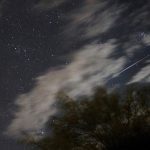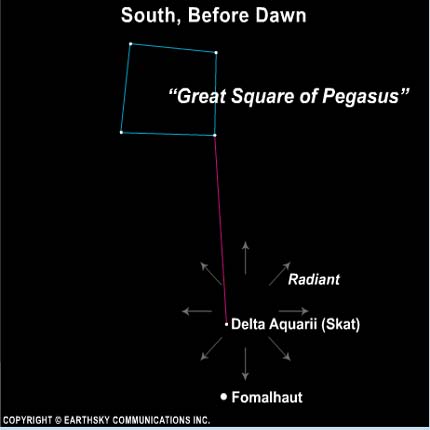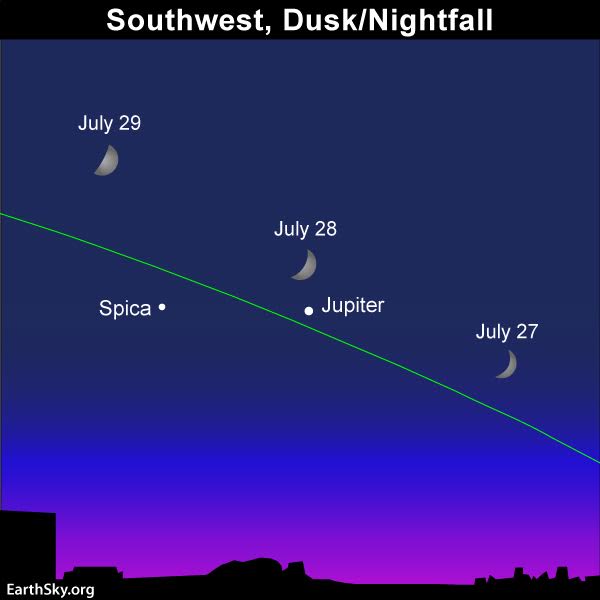
Image at top: Kelly Dreller in Lake Havasu City, Arizona caught this meteor in late July of 2016.
Every year, people look forward to August’s Perseid meteor shower. And it’s wonderful, with regular rates of about 60 meteors per hour at its peak. The Perseids are gearing up even now, so if you go outside between midnight and dawn tonight or this weekend, you might see a few. But there’s also another meteor shower that peaks each year in late July and then rolls along fairly steadily into August, to overlap with the Perseids at their peak. That late July/ early August meteor shower is called the Delta Aquariids.
The Perseids will peak this year on the mornings of August 11, 12 and 13. The Delta Aquarids don’t have as definite a peak as the Perseids. Instead, the shower produces a steady supply of meteors for some weeks in late July and early August, with a nominal peak around July 28. Tonight, this weekend, the coming week are all good times to watch because – on all of these nights – there’s no moon in the sky in the Delta Aquariids peak hours, the dark hours before dawn.
Before dawn? Yes. You’ll have better luck with the Delta Aquariids if you watch from about midnight to dawn. That’s true of most meteor showers. After midnight, your part of Earth will have turned you to face head-on into the meteor stream. The meteors will be entering your sky from a point higher in your sky than earlier in the evening.
Another way to think about this is that – after midnight – the shower’s radiant point will be higher in your sky.
Under a dark sky, between midnight and dawn – tonight, this weekend or in the coming week – you might see as many as 10 meteors per hour. Most will be somewhat faint, so be sure to find a dark sky!
Yes, you can watch from the South Hemisphere, too! The Delta Aquarids, especially, are a good shower for you. The Delta Aquarids fall more abundantly in the Southern Hemisphere, featuring perhaps 15 Delta Aquarid meteors per hour in an inky dark sky. All around the world, the radiant of the shower climbs highest up for the night around 2 to 3 a.m. local time (3 to 4 a.m. local Daylight Time), but the radiant soars way higher in the Southern Hemisphere than at comparable latitudes in the Northern Hemisphere.
Read more: How to find the Delta Aquariid radiant point
Here’s a custom sunrise/set calendar (check the moonrise/set box).
Find out when the moon sets in your sky via TimeaandDate.com.

Radiant point of Delta Aquarid meteor shower. Click here for a post on how to find it in your sky. The Delta Aquarid radiant point is close to the ecliptic, or sun’s path across our sky. If you trace the paths of a Delta Aquarid meteor backwards, you’d find the star Delta Aquarii – also called Skat – nearly coinciding with the radiant.

Radiant point of Perseid meteor shower. You can tell a Perseid meteor from a Delta Aquarid, because the showers have 2 different radiant points; in other words, the meteors radiate from 2 different directions in the sky. Here’s the Perseid radiant, rising in the northeast around midnight.
The Perseid shower is expected to produce the greatest number of meteors on the night of August 11-12 or 12-13, 2020. Last quarter moon – a moon that rises at midnight and appears half-illuminated in our sky – comes on August 11, 2020. That morning – and the mornings after that – a bright moon will interfere to some extent with the peak of the Perseid meteor shower.
You can try watching the Perseids in moonlight. You’ll definitely see a few of the brighter ones, if you do. But – for meteor-shower lovers – right now might be a better time to watch meteors in 2020, before moonlight becomes too overpowering. The Perseids are known to rise to a peak gradually, so they’ll be increasing in numbers every night over the coming week.
At the same time, the moon will be increasing in brilliance and edging into the post-midnight sky.
Meanwhile, the Delta Aquarids will be raining down steadily, night after night.
Which night will be best? No idea. That’ll depend on your local conditions and on the whims of nature. Try watching a number of different nights, and see what you’ll see!

Outside on the evening of July 27, and notice a bright “star” near the moon? It’s not a star. It’s the planet Jupiter. The moon and Jupiter will be even closer on July 28. The nearby bright star is Spica in the constellation Virgo the Maiden.
Bottom line: Given dark skies, you might see as many as 10 to 15 meteors per hour this weekend and in the coming week, in the hours between midnight and dawn. You’ll have more moon-free time during those peak predawn hours in late July 2020 than during the Perseids’ peak on the mornings of August 11, 12 and 13.
EarthSky astronomy kits are perfect for beginners. Order yours today.
EarthSky’s meteor shower guide for 2020
from EarthSky https://ift.tt/3jAD34E

Image at top: Kelly Dreller in Lake Havasu City, Arizona caught this meteor in late July of 2016.
Every year, people look forward to August’s Perseid meteor shower. And it’s wonderful, with regular rates of about 60 meteors per hour at its peak. The Perseids are gearing up even now, so if you go outside between midnight and dawn tonight or this weekend, you might see a few. But there’s also another meteor shower that peaks each year in late July and then rolls along fairly steadily into August, to overlap with the Perseids at their peak. That late July/ early August meteor shower is called the Delta Aquariids.
The Perseids will peak this year on the mornings of August 11, 12 and 13. The Delta Aquarids don’t have as definite a peak as the Perseids. Instead, the shower produces a steady supply of meteors for some weeks in late July and early August, with a nominal peak around July 28. Tonight, this weekend, the coming week are all good times to watch because – on all of these nights – there’s no moon in the sky in the Delta Aquariids peak hours, the dark hours before dawn.
Before dawn? Yes. You’ll have better luck with the Delta Aquariids if you watch from about midnight to dawn. That’s true of most meteor showers. After midnight, your part of Earth will have turned you to face head-on into the meteor stream. The meteors will be entering your sky from a point higher in your sky than earlier in the evening.
Another way to think about this is that – after midnight – the shower’s radiant point will be higher in your sky.
Under a dark sky, between midnight and dawn – tonight, this weekend or in the coming week – you might see as many as 10 meteors per hour. Most will be somewhat faint, so be sure to find a dark sky!
Yes, you can watch from the South Hemisphere, too! The Delta Aquarids, especially, are a good shower for you. The Delta Aquarids fall more abundantly in the Southern Hemisphere, featuring perhaps 15 Delta Aquarid meteors per hour in an inky dark sky. All around the world, the radiant of the shower climbs highest up for the night around 2 to 3 a.m. local time (3 to 4 a.m. local Daylight Time), but the radiant soars way higher in the Southern Hemisphere than at comparable latitudes in the Northern Hemisphere.
Read more: How to find the Delta Aquariid radiant point
Here’s a custom sunrise/set calendar (check the moonrise/set box).
Find out when the moon sets in your sky via TimeaandDate.com.

Radiant point of Delta Aquarid meteor shower. Click here for a post on how to find it in your sky. The Delta Aquarid radiant point is close to the ecliptic, or sun’s path across our sky. If you trace the paths of a Delta Aquarid meteor backwards, you’d find the star Delta Aquarii – also called Skat – nearly coinciding with the radiant.

Radiant point of Perseid meteor shower. You can tell a Perseid meteor from a Delta Aquarid, because the showers have 2 different radiant points; in other words, the meteors radiate from 2 different directions in the sky. Here’s the Perseid radiant, rising in the northeast around midnight.
The Perseid shower is expected to produce the greatest number of meteors on the night of August 11-12 or 12-13, 2020. Last quarter moon – a moon that rises at midnight and appears half-illuminated in our sky – comes on August 11, 2020. That morning – and the mornings after that – a bright moon will interfere to some extent with the peak of the Perseid meteor shower.
You can try watching the Perseids in moonlight. You’ll definitely see a few of the brighter ones, if you do. But – for meteor-shower lovers – right now might be a better time to watch meteors in 2020, before moonlight becomes too overpowering. The Perseids are known to rise to a peak gradually, so they’ll be increasing in numbers every night over the coming week.
At the same time, the moon will be increasing in brilliance and edging into the post-midnight sky.
Meanwhile, the Delta Aquarids will be raining down steadily, night after night.
Which night will be best? No idea. That’ll depend on your local conditions and on the whims of nature. Try watching a number of different nights, and see what you’ll see!

Outside on the evening of July 27, and notice a bright “star” near the moon? It’s not a star. It’s the planet Jupiter. The moon and Jupiter will be even closer on July 28. The nearby bright star is Spica in the constellation Virgo the Maiden.
Bottom line: Given dark skies, you might see as many as 10 to 15 meteors per hour this weekend and in the coming week, in the hours between midnight and dawn. You’ll have more moon-free time during those peak predawn hours in late July 2020 than during the Perseids’ peak on the mornings of August 11, 12 and 13.
EarthSky astronomy kits are perfect for beginners. Order yours today.
EarthSky’s meteor shower guide for 2020
from EarthSky https://ift.tt/3jAD34E

Aucun commentaire:
Enregistrer un commentaire